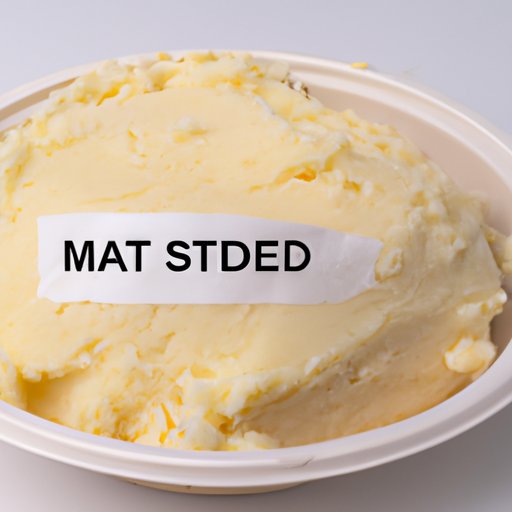I. Introduction
Mashed potatoes are a staple food on many dinner tables. Whether you’re cooking up a batch of creamy mashed potatoes for your family or hosting a holiday feast, nothing complements the meal more than a delicious side of mashed potatoes. However, one of the most common problems with making mashed potatoes is getting the perfect texture. Sometimes they turn out too runny or watery, which isn’t the ideal consistency that we’re all looking for when it comes to this tasty side dish. Fortunately, there are some tips and tricks for making mashed potatoes thicker and creamier! Read on to discover how to transform your mashed potatoes into a decadent and delicious side dish that will impress all your guests.
II. Experiment with Different Potato Varieties
The first thing to consider when making mashed potatoes is choosing the right potato variety. Some potatoes are better suited for mashed potatoes than others. Generally, high-starch potatoes like Yukon Golds and Russets are the best choice for creating fluffy and thick mashed potatoes compared to waxy varieties like fingerling or red potatoes.
Begin by selecting evenly sized potatoes and making sure they have no green coloration. These are indicative of the presence of solanine, a compound that can cause an unpleasant bitter taste and other symptoms. Once you have a good selection of potatoes, ensure you scrub them thoroughly with a brush to remove any dirt or debris before boiling them.
III. Be Mindful of How Much Liquid You Add
When you add too much liquid (such as milk or cream) to mashed potatoes, your end result will be a runny consistency; a common mistake many people make. The trick to getting the perfect mashed potato texture is to slowly add the liquid until you achieve the desired consistency. If you’re concerned about adding too much liquid, consider using less and replacing it with butter. Using more butter and less milk or cream will give your mashed potatoes a creamier texture. For example, add 1/4 cup butter and 1/8 cup cream or milk to four cups of cooked, mashed potatoes, and adjust the ratio from there.
IV. Add Cheese
Adding cheese to your mashed potatoes not only makes them supremely tasty, but it also helps thicken the mixture. Cheddar cheese, parmesan cheese, and cream cheese are all excellent options to consider. The consistency of the potatoes will depend on the type of cheese you use. Cheddar cheese and Parmesan cheese add a cheesy, thick texture, whereas cream cheese adds a creamy texture and milder taste.
To ensure the cheese properly mixes with the mashed potatoes, add your preferred type of cheese when you are blending the potatoes together. Make sure the cheese is at room temperature or slightly warmed so that it will easily incorporate with the mixture and won’t clump.
V. Use a Potato Ricer or Food Processor
When you want perfectly smooth and creamy mashed potatoes, the best tools for the job are a potato ricer or food processor. Both of these tools work to break down the potatoes into small pieces, making them easier to blend together and create a consistent texture. A potato ricer tends to work better for mashed potatoes as it produces a finer texture. In contrast, a food processor can overwork the potatoes, which may cause them to become gluey and less desirable.
If you decide to use a food processor, chop the cooked potatoes into smaller pieces and pulse the machine for no more than one to two minutes.
VI. Use Cornstarch or Flour
Using cornstarch or flour is another option to consider if you’re looking for ways to thicken up your mashed potatoes. Cornstarch is a great option for those who don’t want to alter the flavor of mashed potatoes. Simply add one tablespoon of cornstarch to a slurry of two tablespoons of water and disperse it evenly into the mashed potatoes. If you prefer to use flour, make a flour slurry by mixing one tablespoon of flour and two tablespoons of water, then add it to the mashed potatoes.
When using cornstarch or flour, use a small amount and gradually add more until you achieve the desired consistency. Be aware that using either of these powders can add a slightly sweet flavor to the finished product and may require the addition of additional salt and pepper.
VII. Cook Potatoes with the Skins On
If you’re looking for an extra boost to thicken up your mashed potatoes, try cooking the potatoes with the skins on. This simple step will help to preserve the natural starches in the potatoes, keeping them from getting too waterlogged when you boil them. Once the potatoes are cooked, remove the skins and process them into mashed potatoes. Using this method can result in mashed potatoes with a richer potato flavor.
VIII. Conclusion
Whether you’re cooking up mashed potatoes for a weeknight dinner or a special occasion, getting the perfect consistency can be a challenge. The tips and tricks offered in this article are an excellent starting point for making mashed potatoes that are thick, creamy, and delicious. Remember to experiment with different potato varieties, be mindful of how much liquid you add, use cheese, consider using a potato ricer or food processor, use cornstarch or flour if needed, and cook potatoes with the skins on for an added boost to the flavour.
By following these suggestions, you’ll be well on your way to creating a perfect batch of mashed potatoes that your family and guests will love.
